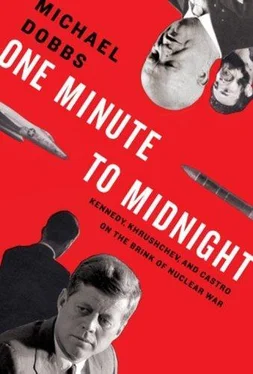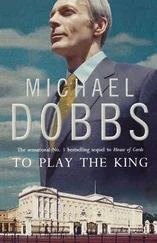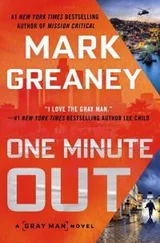Pliyev had accepted the Cuba post reluctantly, out of a sense of duty. He had protested vehemently when told he would have to adopt a pseudonym, Pavlov, for security reasons. Plagued with gallbladder and kidney problems, he was a sick man when he flew into Havana in July 1962 aboard a giant Tu-114 belonging to the Soviet airline Aeroflot. The tropical climate did not agree with him. His gallstones worsened and he spent much of his time in bed. By the end of September, he was in intense pain and on the critical list. Some of the other generals proposed sending the patient back to Moscow, but the commander refused to leave. Gradually, his condition improved. One of the Soviet Union’s top urologists arrived in Havana in mid-October to treat Pliyev, just as the United States learned of the existence of the missile sites.
The general explained the situation quickly. The Americans had imposed a naval blockade; he was declaring a full combat alert; everybody must return to their regiments immediately to repel a possible American paratroop drop.
As the commanders left El Chico for the nighttime journey back to their regiments, the roads were already full of trucks and buses transporting Cuban reservists to their posts. There were checkpoints everywhere, but the companeros sovieticos were waved through to shouts of “ Viva Cuba, Viva la Union Sovietica.”
“Cuba si, yanqui no,” the militiamen chanted. “ Patria o muerte.”
The whole country was suddenly on a war footing. As news spread of Kennedy’s speech and the mobilization of the Cuban armed forces, bewildered Soviet soldiers realized that they might soon be at war with the United States over a thin slither of land on the opposite side of the world to their homeland.
3:00 A.M. TUESDAY, OCTOBER 23 (10:00 A.M. MOSCOW)
Forbidden by Khrushchev to leave the Kremlin, Soviet leaders spent an uncomfortable night in their offices on couches and chairs. They met again at 10:00 a.m. to approve the documents drafted overnight by Foreign Ministry officials, including the official Soviet government statement. Orders had already gone out, starting at 6:00 a.m., to sixteen Soviet ships to return home. The major piece of unfinished business was what to do with the four Foxtrot submarines.
The submarines were still three days’ sailing time from Cuba. They were scattered across the ocean, but the leading sub was nearing the Turks and Caicos Islands, at the entrance to the Caribbean. Anastas Mikoyan, the most cautious member of the Presidium, wanted to hold the submarines back. He feared their presence in Cuban waters would only increase the risk of a confrontation between the U.S. and Soviet navies. If they continued their journey to Cuba, it was likely they would be detected by American warships. Malinovsky argued that the Foxtrots should proceed on course to the Cuban port of Mariel, where they were meant to set up a submarine base. Several Presidium members supported the minister of defense. Khrushchev let the debate swirl around him. He could not make up his mind.
The argument was finally resolved by the head of the Soviet navy, Admiral Sergei Gorshkov. He was not present at the overnight Presidium meeting, but was invited to address a session later in the day. It was difficult to fault his expertise. Gorshkov had been personally selected by Khrushchev to create a modern navy capable of projecting Soviet power to the borders of America from what had previously been a largely defensive coastal force. He had joined the navy at the age of seventeen and became admiral during World War II at the age of thirty-one. Now fifty-two, he enjoyed a reputation for both dynamism and professionalism. He was known as a hard taskmaster.
The admiral laid his naval charts out on the Presidium’s baize-covered table. He pointed out the positions of the four Foxtrots, between 300 and 800 miles from Cuba. He then noted the chokepoints on the sea-lanes to the Caribbean. The direct routes to Cuba from the Atlantic all passed through a 600-mile chain of islands stretching in a southeasterly direction from the Bahamas to the Turks and Caicos. The widest passage through the archipelago measured only forty miles. The only way to avoid this thicket of islands was to skirt the eastern tip of Grand Turk Island, toward Haiti and the Dominican Republic, adding at least two days to the journey.
Gorshkov sided with Mikoyan. He explained that the Americans controlled the narrow sea passages with submarine location equipment, and it was impossible to pass through them without being detected. He agreed that the submarines should be held back two or three days’ sailing time from Cuba. In notes dictated shortly after the crisis, Mikoyan recalled that Malinovsky was “unable to object” to the navy chief’s presentation. The admiral had performed “a very useful service”: He had shown the defense minister to be “incompetent.”
Mikoyan breathed a sigh of relief. He congratulated himself on averting an immediate superpower confrontation. But the respite proved temporary. The U.S. Navy was already bearing down on the Soviet submarines.
There was one more piece of urgent business falling to the KGB secret police. For the past year, a Soviet military intelligence officer named Colonel Oleg Penkovsky had been providing top secret documents to his British and American handlers. Among the documents now in the hands of the CIA was the technical manual for the R-12 missile system, together with the layout of a typical missile site and detailed descriptions of the various readiness levels. Penkovsky had been under suspicion for weeks, but the KGB delayed moving against him because it wanted to smash the entire spy ring.
With the Cold War on the verge of turning hot, Penkovsky could not be permitted to feed any more information to the Americans. Plain-clothes agents burst into his apartment on the Moscow River and arrested him without a struggle. Because of the importance of the case, the head of the KGB, Vladimir Semichastny, decided that he would take personal charge of the interrogation. He ordered his men to bring the traitor to his third-floor corner office in the Lubyanka. They sat him down at the other end of a long conference table.
Fearing torture or worse, Penkovsky immediately offered to cooperate with the KGB “in the interests of the motherland.”
Semichastny looked at him with distaste. “Tell me what harm you have inflicted on our country. Describe it all in detail, with the most pertinent facts.”
6:45 A.M. TUESDAY, OCTOBER 23 (5:45 A.M. HAVANA)
A week after the discovery of the Soviet missiles, CIA analysts were still unable to answer the president’s most urgent question: where are the nuclear warheads? They had reexamined all the U-2 pictures to look for telltale signs of a nuclear storage site, such as extra security fencing and antiaircraft protection. Radiation detection devices were being supplied to U.S. ships enforcing the blockade to try to determine whether nuclear warheads were being smuggled into Cuba.
The photo interpreters had identified several possible storage sites, including an abandoned molasses factory protected by an unusual system of double fencing. At several missile sites, construction was proceeding rapidly on bunkers made out of prefabricated aluminum arches, similar to nuclear storage facilities in the Soviet Union. Despite these promising leads, there was no firm evidence of the presence of nuclear warheads on the island.
In fact, the Soviet nuclear arsenal on Cuba far exceeded the worst nightmares of anyone in Washington. It included not only the big ballistic missiles targeted on the United States but an array of smaller weapons that could wipe out an invading army or navy. There were nukes for short-range cruise missiles, nukes for Ilyushin-28 bombers, and nukes for tactical rockets known as Lunas.
Читать дальше












